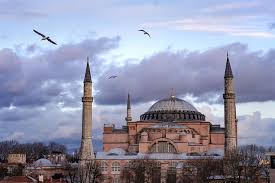Introduction
Standing majestically in the heart of Istanbul, Hagia Sophia is one of the world’s most iconic architectural masterpieces. Known as a symbol of cultural fusion, it embodies centuries of history, religion, and artistic brilliance. From a Byzantine cathedral to an Ottoman mosque, and now a museum and mosque, Hagia Sophia tells the story of a city where East meets West.
This article explores the history, architecture, cultural significance, and enduring legacy of Hagia Sophia, highlighting why it remains a must-visit destination and a symbol of harmony across cultures.
The Historical Journey of Hagia Sophia
The name Hagia Sophia means “Holy Wisdom” in Greek. Its history spans over 1,500 years, reflecting the changing tides of empires, religions, and cultures.
Byzantine Era (537 – 1453)
Hagia Sophia was originally constructed as a Christian cathedral by Emperor Justinian I in 537 AD. At the time, it was the largest cathedral in the world, celebrated for its grand dome and innovative architectural design. The church became the center of Eastern Orthodox Christianity, hosting coronations, ceremonies, and religious festivals.
Ottoman Era (1453 – 1935)
After the Ottoman conquest of Constantinople in 1453, Sultan Mehmed II converted Hagia Sophia into a mosque. Minarets were added, Islamic calligraphy adorned the walls, and the building became a symbol of Ottoman power and Islamic culture. Despite its conversion, many Byzantine mosaics were preserved, creating a unique blend of Christian and Islamic artistry.
Modern Era (1935 – Present)
In 1935, Hagia Sophia was secularized and turned into a museum by Mustafa Kemal Atatürk, the founder of modern Turkey, allowing people from all over the world to appreciate its historical and artistic significance. In 2020, it was reconverted into a mosque, yet it continues to welcome visitors globally, representing a living testament to cultural coexistence.
Architectural Brilliance of Hagia Sophia
Hagia Sophia is a masterpiece of Byzantine architecture, known for its innovative engineering, massive dome, and artistic decorations.
The Dome
-
The main dome spans 31 meters in diameter and rises 55 meters above the ground.
-
Supported by pendentives and massive piers, it creates a sense of floating grandeur, influencing church and mosque designs for centuries.
Interior Design
-
The interior features marble columns, golden mosaics, and intricate geometric patterns.
-
Byzantine mosaics depict Christ, the Virgin Mary, and various saints, reflecting the Christian heritage.
-
Islamic elements include calligraphy, mihrab, minbar, and minarets, added during the Ottoman era.
Structural Innovations
-
The combination of arches, buttresses, and semi-domes allows the massive structure to remain stable for centuries.
-
Hagia Sophia influenced architectural wonders such as Sultan Ahmed Mosque (Blue Mosque) and other Ottoman mosques worldwide.
Cultural Fusion and Significance
Hagia Sophia represents a unique cultural and religious fusion:
-
Christian and Islamic Heritage: The building seamlessly integrates Byzantine mosaics and Islamic calligraphy, symbolizing coexistence and mutual respect.
-
East Meets West: Its design reflects the blending of Eastern architectural techniques with Western artistic traditions.
-
Symbol of Tolerance: Despite changes in function, Hagia Sophia remains a place where history, culture, and faith intersect, inviting visitors of all backgrounds.
-
Inspiration for Art and Architecture: Artists, architects, and historians worldwide study Hagia Sophia for its innovative engineering and aesthetic excellence.
Visiting Hagia Sophia Today
Located in Sultanahmet Square, Istanbul, Hagia Sophia attracts millions of visitors annually. Its timeless beauty, historical significance, and spiritual ambiance make it a must-visit cultural landmark.
Highlights for Visitors
-
Main Dome and Nave: Experience the grandeur and engineering marvel of the central dome.
-
Byzantine Mosaics: Admire intricate mosaics of religious figures, many restored to preserve their original beauty.
-
Ottoman Features: Explore calligraphy, mihrab, and minarets added during the mosque conversion.
-
Museum and Cultural Experience: Learn about the rich history through guided tours, exhibitions, and educational resources.
Visitors are encouraged to respect the sacred nature of the site while exploring its rich historical layers.
Hagia Sophia in Modern Culture
Hagia Sophia continues to inspire contemporary culture:
-
Photography and Art: Its domes, mosaics, and arches make it a favorite subject for photographers and artists.
-
Education and Research: Scholars study its architecture, mosaics, and cultural history worldwide.
-
Tourism and Economy: Hagia Sophia plays a significant role in Istanbul’s tourism industry, attracting millions and contributing to cultural preservation.
Its enduring legacy demonstrates that architecture can bridge cultures, religions, and generations.
Challenges and Preservation
Maintaining Hagia Sophia is a complex task due to its age, environmental factors, and structural demands. Preservation efforts focus on:
-
Restoring mosaics and artwork without compromising historical authenticity.
-
Strengthening the structure to withstand earthquakes.
-
Balancing religious use with tourism and cultural heritage preservation.
These efforts ensure that Hagia Sophia remains intact and accessible for future generations.
Why Hagia Sophia is a Symbol of Cultural Fusion
Hagia Sophia is more than a building; it is a living symbol of human ingenuity and cultural collaboration. Its ability to blend religious, historical, and artistic traditions makes it a unique example of cultural fusion.
-
Religious Tolerance: Coexistence of Christian and Islamic elements encourages dialogue and understanding.
-
Architectural Innovation: Combines Eastern engineering with Western artistic sensibilities.
-
Global Inspiration: Inspires architects, historians, and travelers worldwide, emphasizing the value of preserving heritage.
Conclusion
Hagia Sophia, Turkey – Cultural Fusion is a monumental reminder that history, religion, and art can coexist in harmony. Its rich past, stunning architecture, and symbolic significance make it a timeless treasure of Istanbul and the world.


You must be logged in to post a comment.